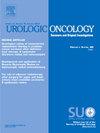加利福尼亚州肾细胞癌患者使用肾部分切除术和根治性肾切除术的模式受种族和付款人状况的影响。
IF 2.4
3区 医学
Q3 ONCOLOGY
Urologic Oncology-seminars and Original Investigations
Pub Date : 2025-03-01
DOI:10.1016/j.urolonc.2024.11.026
引用次数: 0
摘要
背景:前瞻性试验显示局部肾细胞癌(RCC)患者部分肾切除术(PN)的结果相似,多项研究表明该技术的使用正在增加。我们假设来自少数群体的患者,以及医疗保险和医疗保险的患者,很少有机会接受这种专门的手术,因此,根治性肾切除术(RN)的比例更高。方法:我们询问了加州全州健康规划与发展办公室(OSHPD)数据库,该数据库收集了该州所有住院患者、急诊室就诊和住院/门诊程序的信息。采用CPT和ICD-9/10代码识别2012年至2018年期间所有因RCC接受肾切除术的患者,以识别接受RN和PN的RCC患者。感兴趣的变量包括患者人口统计、合并症、付款人状况和进行手术的机构类型。我们进行了单变量和多变量分析,以探讨患者因素与所行肾切除术类型之间的关系。结果:在研究期间,总共有31,093名患者接受了肾切除术。总体而言,男性占57%,平均年龄为58岁。PN和RN分别为15840例(50.9%)和15253例(49.1%)。PN率因种族/民族而异,白人患者8576人(53.1%),黑人患者1124人(55.3%),亚洲患者1286人(46.0%),西班牙患者4107人(47.5%),其他种族患者747人(50.5%)(P < 0.001)。不同支付者使用PN的情况也不同,私人医疗有6800人(56.4%),医疗保险有5036人(43.9%),医疗有1817人(38.3%),其他保险有2187人(77.7%)(P < 0.001)。在控制年龄、性别、合并症和虚弱的多变量分析中,种族与肾切除术的类型独立相关,但与付款方式无关。结论:我们的研究证实,种族和付款人身份可能会影响部分根治性肾切除术的使用率,黑人患者和有私人保险的患者的部分肾切除术率最高。虽然存在多种潜在的混杂因素(例如,诊断的延迟和由此产生的肿瘤大小/复杂性),但获得护理可能是这一现象的驱动因素。本文章由计算机程序翻译,如有差异,请以英文原文为准。
Impact of race and payor status on patterns of utilization of partial and radical nephrectomy in patients with renal cell carcinoma in California
Background
Prospective trials have shown similar outcomes with partial nephrectomy (PN) in patients with localized renal cell carcinoma (RCC), and multiple studies suggest increasing the use of the technique. We hypothesize that patients who stem from minority groups, as well as Medicare and Medical, have less access to this specialized procedure and, therefore, have a higher rate of radical nephrectomy (RN).
Methods
We interrogated the California Office of Statewide Health Planning and Development (OSHPD) database, which collects information from all inpatient admissions, emergency room visits and inpatient/outpatient procedures in the state. All patients undergoing nephrectomy for RCC were identified from 2012 to 2018 using CPT and ICD-9/10 codes to identify patients with RCC undergoing RN and PN. Variables of interest included patient demographics, comorbidities, payor status and type of institution where the surgery was performed. We performed univariate and multivariable analysis to explore associations between patient factors and type of nephrectomy performed.
Results
In total, 31,093 patients who had undergone a nephrectomy in the study period were identified. Overall, most were 57% male, with a mean age of 58 years. PN and RN were performed in 15,840 (50.9%) and 15,253 (49.1%) patients, respectively. PN rates differed according to race/ ethnicity, as it was performed in 8576 (53.1%) White, 1124 (55.3%) Black, 1286 (46.0%) Asian, 4107 (47.5%) Hispanic and 747 (50.5%) other race patients (P < 0.001). Use of PN also differed among patients based on payor status, with 6800 (56.4%) private, 5,036 (43.9%) Medicare, 1,817 (38.3%) Medical, and 2,187 (77.7%) other insurance patients (P < 0.001). On multivariate analysis controlling for age, gender, comorbidities, and frailty, race was independently associated with the type of nephrectomy, but payor was not.
Conclusions
Our study confirms that race and payor status may have an influence on the utilization of partial versus status radical nephrectomy, with the highest rate of partial nephrectomies among Black patients and those with private insurance. Although there are multiple potential confounders (e.g., latency of diagnosis and resulting tumor size/complexity), it is possible access to care is a driver of this phenomenon.
求助全文
通过发布文献求助,成功后即可免费获取论文全文。
去求助
来源期刊
CiteScore
4.80
自引率
3.70%
发文量
297
审稿时长
7.6 weeks
期刊介绍:
Urologic Oncology: Seminars and Original Investigations is the official journal of the Society of Urologic Oncology. The journal publishes practical, timely, and relevant clinical and basic science research articles which address any aspect of urologic oncology. Each issue comprises original research, news and topics, survey articles providing short commentaries on other important articles in the urologic oncology literature, and reviews including an in-depth Seminar examining a specific clinical dilemma. The journal periodically publishes supplement issues devoted to areas of current interest to the urologic oncology community. Articles published are of interest to researchers and the clinicians involved in the practice of urologic oncology including urologists, oncologists, and radiologists.

 求助内容:
求助内容: 应助结果提醒方式:
应助结果提醒方式:


